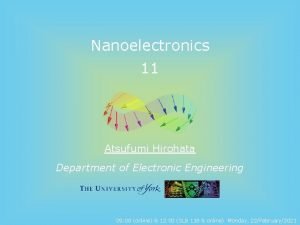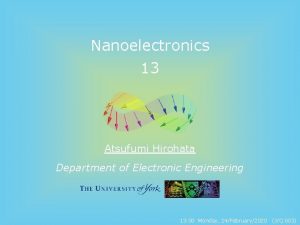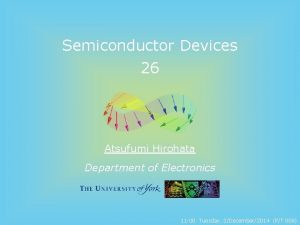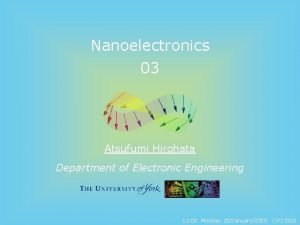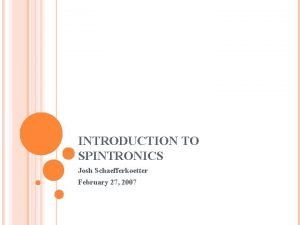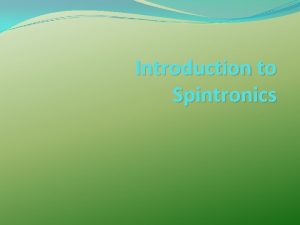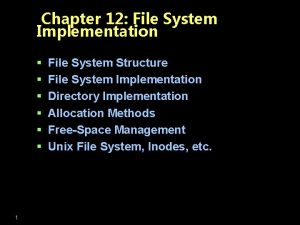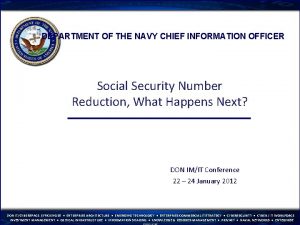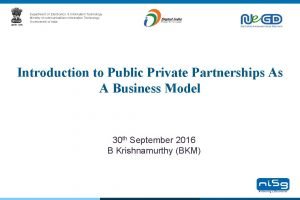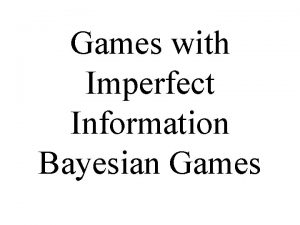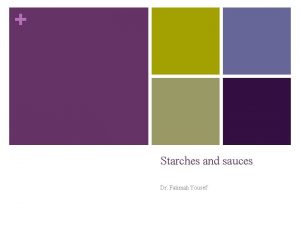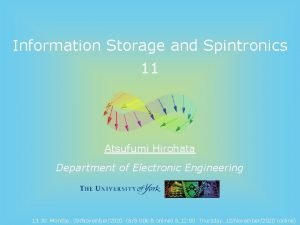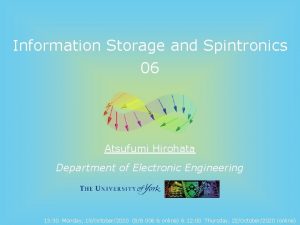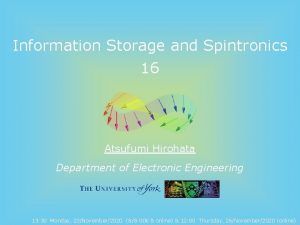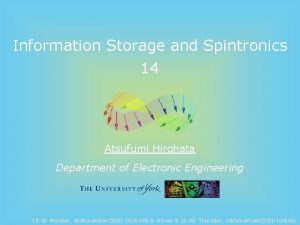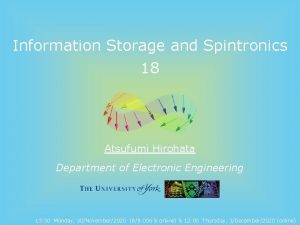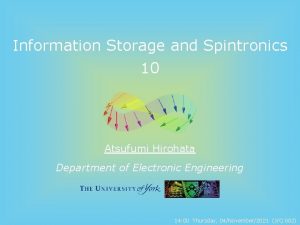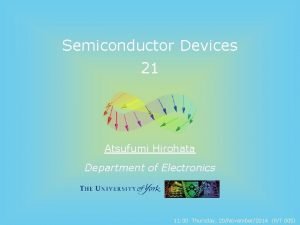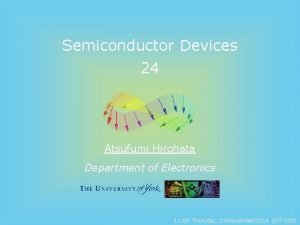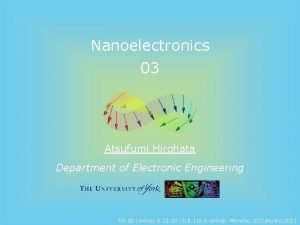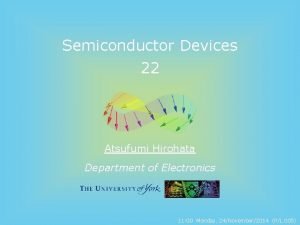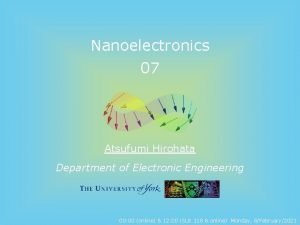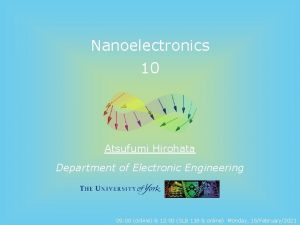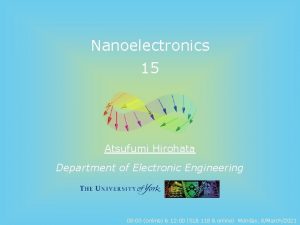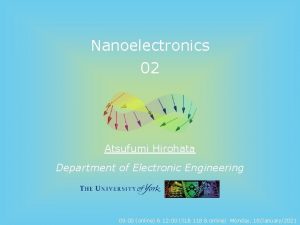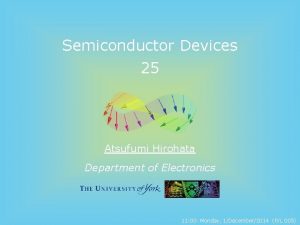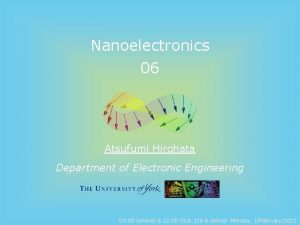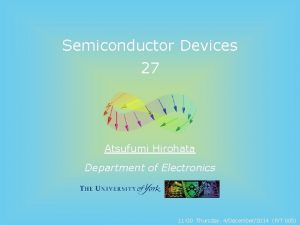Information Storage and Spintronics 02 Atsufumi Hirohata Department
























- Slides: 24

Information Storage and Spintronics 02 Atsufumi Hirohata Department of Electronic Engineering 13: 30 Monday, 05/October/2020 (B/B 006 & online) & 12: 00 Thursday, 08/October/2020 (online)

Contents of Information Storage and Spintronics Lectures : Atsufumi Hirohata (atsufumi. hirohata@york. ac. uk, P/Z 019) Advancement in information storages and spintronics (Weeks 2 ~ 9) All lectures will be uploaded weekly in advance at http: //www-users. york. ac. uk/~ah 566/lectures. html 13: 30 ~ 14: 30 Mons. (B/B 006 & online – Zoom) 12: 00 ~ 13: 00 Thus. (online – Zoom) I. Introduction to information storage (01 & 02) II. Magnetic information storages (03 ~ 06) III. Solid-state information storages (07 ~ 11) IV. Spintronic devices (12 ~ 18) Practicals : Analysis on a spintronic device using XRD, VSM, MFM and MR (Weeks 3 ~ 8) Operation, data and instruction will be uploaded weekly in advance at http: //www-users. york. ac. uk/~ah 566/lectures. html 09: 00 ~ 11: 00 Weds. (online – Zoom) Continuous Assessment : Assignment to be submitted via VLE (Week 10).

Quick Review over the Last Lecture Von Neumann’s model : ( • CPU ) ( • Input ) ( • Output ) Memory access : ( • Working storage) ( ) • Permanent storage Bit / byte : • 1 bit : • 2 1 = (2 combinations) • 1 digit in binary number • 1 byte (B) = (8 bit ) * http: //testbench. in/introduction_to_pci_express. html;

02 Binary Data • Binary numbers • Conversion • Advantages • Logical conjunctions • Adders • Subtractors

Bit and Byte Bit : “Binary digit” is a basic data size in information storage. 1 bit : 2 1 = 2 combinations ; 1 digit in binary number 2 22 = 4 2 3 23 = 8 3 4 2 4 = 16 4 : : Byte : A data unit to represent one letter in Latin character set. 1 byte (B) = 8 bit 1 k. B = 1 B × 1024 1 MB = 1 k. B × 1024 : :

Binary Numbers The modern binary number system was discovered by Gottfried Leibniz in 1679 : * Decimal notation Binary notation 0 0 1 1 2 10 3 11 4 100 5 101 6 110 7 111 8 1000 : : * http: //www. oracle. com/

Conversion to Binary Numbers 1 For example, 1192 : 2 ) 1192 = 20 × 1192 2) 586… 0 1192 = 21 × 586 + 20 × 0 2) 293… 0 1192 = 22 × 293 + 21 × 0 + 20 × 0 2) 146… 1 1192 = 23 × 146 + 22 × 1 + 21 × 0 + 20 × 0 2) 73… 0 1192 = 24 × 73 + 23 × 0 + 22 × 1 + 21 × 0 + 20 × 0 2) 36… 1 1192 = 25 × 36 + 24 × 1 + 23 × 0 + 22 × 1 + 21 × 0 + 20 × 0 2) 18… 0 1192 = 26 × 18 + 25 × 0 + 24 × 1 + 23 × 0 + 22 × 1 + 21 × 0 + 20 × 0 2) 9… 0 1192 = 27 × 9 + 26 × 0 + 2 5 × 0 + 2 4 × 1 + 2 3 × 0 + 2 2 × 1 + 2 1 × 0 + 20 × 0 2) 4… 1 1192 = 28 × 4 + 27 × 1 + 2 6 × 0 + 2 5 × 0 + 2 4 × 1 + 2 3 × 0 + 2 2 × 1 + 21 × 0 + 20 × 0 2) 2… 0 1192 = 29 × 2 + 28 × 0 + 2 7 × 1 + 2 6 × 0 + 2 5 × 0 + 2 4 × 1 + 2 3 × 0 + 22 × 1 + 21 × 0 + 20 × 0 2) 1… 0 1192 = 210 × 1 + 29 × 0 + 2 8 × 0 + 2 7 × 1 + 2 6 × 0 + 2 5 × 0 + 2 4 × 1 + 23 × 0 + 22 × 1 + 21 × 0 + 20 × 0 2) 0… 1 1192 10 = 10010010100 2

Conversion to Binary Numbers 2 For example, 0. 1 : 0. 1 × 2 = 0. 2 < 1 0. 0 0. 2 × 2 = 0. 4 < 1 0. 00 0. 4 × 2 = 0. 8 < 1 0. 000 0. 8 × 2 = 1. 6 > 1 0. 0001 0. 6 × 2 = 1. 2 > 1 0. 00011 0. 2 × 2 = 0. 4 < 1 0. 000110 : : 0. 1 10 = 0. 00011 2

Why Are Binary Numbers Used ? In order to represent a number of “ 1192” by ON / OFF lamps : Binary number : 10010010100 2 (11 digits = 11 lamps) Decimal number : 1192 10 (4 digits × 9 = 36 lamps) Similarly, Ternary number : 1122011 3 (7 digits × 2 = 14 lamps) 1192 = 729 + 243 + 162 + 54 + 0+ 3+ 1 = 36 × 1 + 3 5 × 1 + 3 4 × 2 + 3 3 × 2 + 3 2 × 0 + 3 1 × 1 + 3 0 × 1 Quaternary number : 112220 4 (6 digits × 3 = 18 lamps) 1192 = 1024 + 0+ 128 + 32 + 8+ 0 = 45 × 1 + 4 4 × 1 + 4 3 × 2 + 4 2 × 2 + 4 1 × 2 + 4 0 × 0 Binary numbers use the minimum number of lamps (devices) !

Mathematical Explanation In a base-n positional notation, a number x can be described as : x = ny (y : number of digits for a very simple case) In order to minimise the number of devices, i. e. , n × y, ln(x) = y ln(n) Here, ln(x) can be a constant C, C = y ln(n) y = C / ln(n) By substituting this relationship into n × y, n × y = C n / ln(n) To find the minimum of n / ln(n), [n / ln(n)]’ = {ln(n) – 1} / {ln(n)} 2 Here, [n / ln(n)]’ = 0 requires ln(n) – 1 = 0 Therefore, n = e (= 2. 71828…) provides the minimum number of devices.

Logical Conjunctions 1 AND : Venn diagram of A∧B Truth table Input Output A B A∧B True (T) (1) T (1) False (F) (0) T (1) F (0) F (0) A B Logic circuit * http: //www. wikipedia. org/

Logical Conjunctions 2 OR : Venn diagram of A∨B Truth table Input Output A B A∨B T (1) T (1) F (0) F (0) A B Logic circuit * http: //www. wikipedia. org/

Logical Conjunctions 3 NOT : Venn diagram of Ā Truth table Input Output A Ā T (1) F (0) T (1) A Ā Logic circuit * http: //www. wikipedia. org/

Additional Logical Conjunctions 1 NAND = (NOT A) OR (NOT B) = NOT (A AND B) : Venn diagram of A↑ B Truth table Input Output A B A↑ B T (1) F (0) T (1) F (0) T (1) A B Logic circuit * http: //www. wikipedia. org/

Additional Logical Conjunctions 2 NOR = NOT (A OR B) : Venn diagram of A¯B Truth table Input Output A B A¯B T (1) F (0) F (0) T (1) A B Logic circuit NOR can represent all the logical conjunctions : • NOT A = A NOR A • A AND B = (NOT A) NOR (NOT B) = (A NOR A) NOR (B NOR B) • A OR B = NOT (A NOR B) = (A NOR B) NOR (A NOR B) * http: //www. wikipedia. org/

Additional Logical Conjunctions 3 XOR = Exclusive OR : Venn diagram of A⊕ B Truth table Input Output A B A⊕ B T (1) F (0) T (1) F (0) A B Logic circuit * http: //www. wikipedia. org/

Half Adder Simple adder for two single binary digits : XOR for the sum (S) AND for the carry (C), which represents the overflow for the next digit Truth table Input Output A B S C 1 1 0 1 0 1 0 0 0 * http: //www. wikipedia. org/

Full Adder for two single binary digits as well as values carried in (C in) : 2 half adders for sum (S) Input Output Additional OR for the carry (C out), A B C in S C out which represents the overflow 1 1 1 for the next digit 0 1 1 0 1 0 0 1 0 1 0 0 0 Truth table * http: //www. wikipedia. org/

Half Subtractor Simple subtractor for two single binary digits, minuend (A) and subtrahend (B) : XOR for the difference (D) B D A Bor NOT and AND for the borrow (Bor), which is the borrow from the next digit Truth table Input Output A B D Bor 1 1 0 0 0 1 1 0 1 0 0 0 * http: //www. wikipedia. org/

Full Subtractor for two single binary digits as well as borrowed values carried in (Bor in) : 2 half subtractor for difference (D) Input Output Additional OR for the borrow (Bor out), A B Bor in D Bor out which is the borrow from the next 1 1 1 digit 0 1 1 0 1 0 0 1 1 1 0 0 1 0 1 1 1 0 0 0 0 Truth table * http: //www. wikipedia. org/

Information Processing For data processing, two distinct voltages are used to represent “ 1” and “ 0” : Low level (1) and high level (2) voltages Voltages used : Devices Low voltage High voltage Emitter-coupled logic (ECL) - 5. 2 ~ 1. 175 V 0 ~ 0. 75 V Transistor-transistor logic (TTL) 0 ~ 0. 8 V 2 ~ 4. 75 (or 5. 25) V Complementary metal-oxidesemiconductor (CMOS) V DD / 2 ~ V DD 0 ~ V DD / 2 (V DD = 1. 2, 1. 8, 2. 4, 3. 3 V etc. ) * http: //www. wikipedia. org/

Emitter-Coupled Logic In 1956, Hannon S. Yourke invented ECL at IBM : * High-speed integrated circuit, differential amplifier, with bipolar transistors * http: //www. wikipedia. org/

Transistor-Transistor Logic In 1961, James L. Buie invented TTL at TRW : * Integrated circuit, logic gate and amplifying functions with bipolar transistors * http: //www. wikipedia. org/

Complementary Metal-Oxide-Semiconductor In 1963, Frank Wanlass patented CMOS : * Integrated circuit with low power consumption using complementary MOSFET * http: //www. wikipedia. org/
 Atsufumi hirohata
Atsufumi hirohata Fermi velocity
Fermi velocity Shottky
Shottky Atsufumi hirohata
Atsufumi hirohata Atsufumi hirohata
Atsufumi hirohata Atsufumi hirohata
Atsufumi hirohata Atsufumi hirohata
Atsufumi hirohata Introduction to spintronics
Introduction to spintronics Introduction to spintronics
Introduction to spintronics Transferring of data from auxiliary storage to main storage
Transferring of data from auxiliary storage to main storage Storage devices of computer
Storage devices of computer Uses rigid metallic platters
Uses rigid metallic platters Unified storage vs traditional storage
Unified storage vs traditional storage Emc information storage and management
Emc information storage and management Electronics and information technology department odisha
Electronics and information technology department odisha A storage structure consisting of information about a file
A storage structure consisting of information about a file Department of information technology
Department of information technology Department of information engineering university of padova
Department of information engineering university of padova Department of information engineering university of padova
Department of information engineering university of padova Department of the navy chief information officer
Department of the navy chief information officer Department of electronics & information technology
Department of electronics & information technology What is departmental account?
What is departmental account? Incomplete vs imperfect information
Incomplete vs imperfect information Starch is made up of
Starch is made up of San y nas
San y nas
